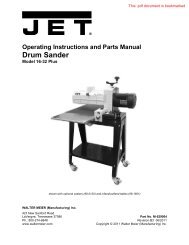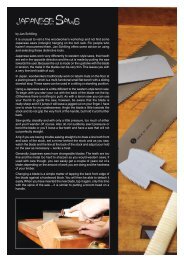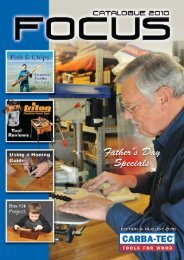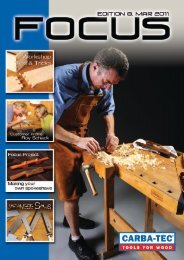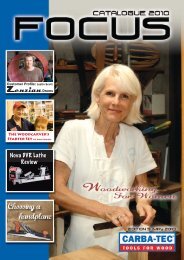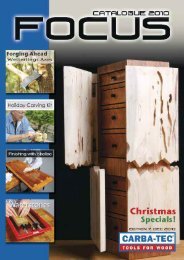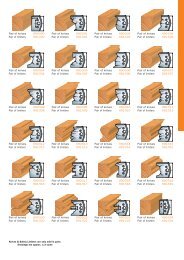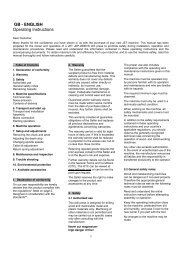Download Catalogue (PDF - 38.2mb) - Carba-Tec
Download Catalogue (PDF - 38.2mb) - Carba-Tec
Download Catalogue (PDF - 38.2mb) - Carba-Tec
Create successful ePaper yourself
Turn your PDF publications into a flip-book with our unique Google optimized e-Paper software.
Original Dinghy Built<br />
by Reg Fazackerley<br />
The Rusich’s Bow<br />
The first of many wooden ships to sail up<br />
the Derwent River was the Lady Nelson in<br />
1803. She was a double-masted, square<br />
rigger known as a ‘Brig’. Aboard were<br />
the crew and first settlers, as well as ten<br />
convicts and three soldiers, that had been<br />
sent to Van Dieman’s Land.<br />
The original ship was lost with all its crew<br />
in 1825, after it was captured by pirates<br />
near Timor. The replica that appeared<br />
at the festival was built in 1988 using<br />
Tasmanian Blue Gum for the keel and<br />
frames, Celery Top Pine decking and masts<br />
of Oregon Pine grown in Tasmania. The<br />
Lady Nelson is based in Hobart and was<br />
one of the stars of the show during the<br />
festival, along with the restored James<br />
Craig, the beautiful Brigantine Windeward<br />
Bound and the Enterprize from Melbourne.<br />
The story of how the Windeward Bound<br />
came to be is one of great tenacity and<br />
belief. The ship was built by the captain,<br />
Sarah Parry and a small group of volunteers<br />
in the 1990s.The hull is strip planked<br />
Swamp Gum and is constructed entirely<br />
from salvaged and recycled material that<br />
Sarah and her crew were able to collect.<br />
Much of it came from old timber ships<br />
awaiting demolition.<br />
The ship is based in Hobart and is now a<br />
sailing training vessel and has guided many<br />
young people into a maritime career. The<br />
crew work with many of the city’s troubled<br />
youth to help restore a sense of belief<br />
in themselves. Sarah explained that she<br />
always knew that this was the real purpose<br />
of the Windeward Bound.<br />
At the opposite end of the scale, the Maritime<br />
Museum in Hobart mounted a display of<br />
exceptional clinker-built dinghies by prolific<br />
local boat builder Reg Fazackerley. These<br />
dinghies epitomise the romantic image of<br />
traditional wooden boats with their curved<br />
planks, ribs and copper roves.<br />
It is believed that Reg built over 100<br />
vessels, the first when he was only 16<br />
years old. They were built using only hand<br />
tools and he worked entirely by eye. Peta<br />
Knott of the Maritime Museum of Tasmania<br />
has been researching the life and work of<br />
Fazackerley. His boats are highly prized and<br />
are now collector’s items with significant<br />
value. The main characteristics of his<br />
dinghies include Huon or King Billy Pine<br />
planks and no ribs forward of the thwart.<br />
(cross brace that also serves as a seat).<br />
The nails are typically clenched below the<br />
thwart riser, then roved above it. One very<br />
endearing feature is the oak knees that<br />
act as braces, they are cut from naturally<br />
grown timber to utilise the strength of the<br />
curved wood grain that grows in tension or<br />
compression and give support where there<br />
is a natural bend or crook in a tree. Using<br />
the properties naturally present in the timber<br />
is a very traditional method of construction<br />
and marks this style of boatbuilding apart<br />
from the more contemporary approach<br />
of laminating. Reg’s dinghies also have a<br />
distinctive curvature to the transom, but<br />
most telling of all, he usually signed and<br />
dated each one with the initials R.F. under<br />
one of the seats.<br />
After a presentation by Peta Knott about<br />
the work of Reg Fazackerley, we met<br />
Bruce Miller who built a clinker dinghy in<br />
1967 under Reg’s tutelage. Bruce told<br />
the wonderful story of the process they<br />
went through together to build his one<br />
and only boat. He still owns it today and<br />
remembers the experience with great<br />
fondness. The dinghy has become a<br />
significant part of his family’s history.<br />
By the end of the four days, it felt as though<br />
some of the people and the boats at the<br />
festival were becoming old friends.<br />
There are many clubs and community<br />
groups that work to faithfully resurrect and<br />
maintain Australia’s maritime heritage.<br />
There is a list of these groups on our<br />
website so if you feel compelled to look<br />
them up, I strongly encourage you to do<br />
so. At the very least you will meet some<br />
interesting people.<br />
Go to the Develop and Discover section of<br />
our website for more stories and images.



